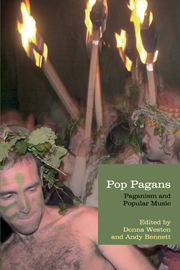Book contents
5 - Pagan metal
from Part II - Genres
Summary
Pagan metal arose from diverse strands of the metal meta-genre, and was initiated by bands spread across Europe's northern tier – from Ireland to Finland – at the start of the last decade of the twentieth century. It is not characterized by a cohesive musical style. Sonically, Pagan metal draws from a wide variety of metal styles, typically incorporating additional features of pre-modern instrumentation, rhythms and melodies. Textual elements, from the specific Pagan references in lyrics to the language in which they are expressed, also diverge widely.
What Pagan metal bands mean by the term “Pagan” varies wildly. The same can be said more generally about practitioners of Paganism today. Pagan metal bands can be grouped into three clusters. One is related to what is often called Neo-Paganism, derived from the work of Gerald Gardner ([1954] 2004) and other nineteenth-century sources that influenced Wiccan groups in the United Kingdom and North America. Gardner “effectively founded modern witchcraft, complete with its magic, tools, festivals, pantheon, and ‘skyclad’ (i.e., naked) rituals, with his book Witchcraft Today” (Sage 2009: 33). Another grouping of Pagan metal bands can be called “roots Paganism”, focused on ancestral pre-Christian cultures – particularly warriors and ancient gods, such as the Vikings and the pantheon of Norse gods. A third set of bands is designated here as “chauvinistic Paganism”, which scapegoats and demonizes those seen to be, or who have been, a threat to one's ethnic heritage – one's “roots”.
- Type
- Chapter
- Information
- Pop PagansPaganism and Popular Music, pp. 58 - 75Publisher: Acumen PublishingPrint publication year: 2013



